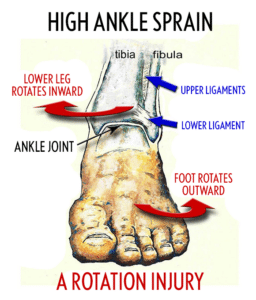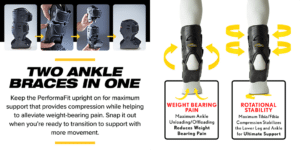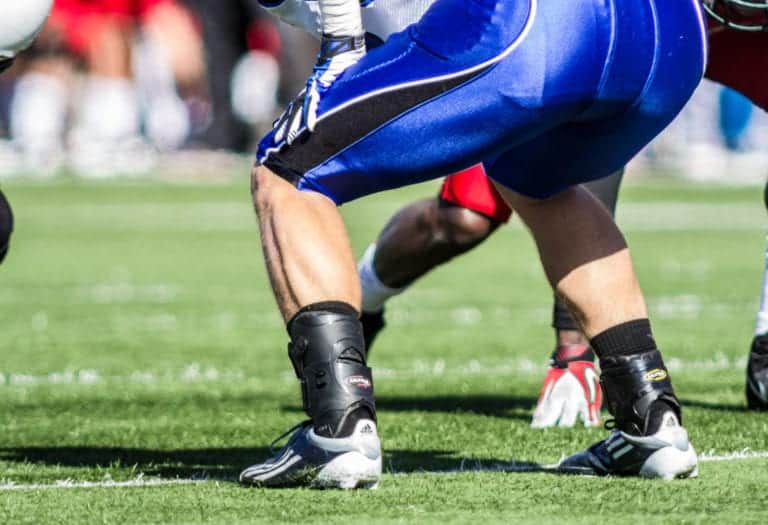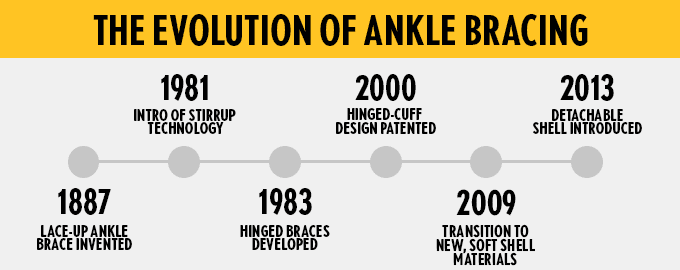
When it comes to preventing ankle injuries or providing support after an injury has occurred, two methods often come to mind – taping the ankle or wearing an ankle brace. These methods are common choices among athletes, athletic trainers, and physiotherapists for providing stability to an injured or unstable ankle. In this blog post, we will discuss the advantages, disadvantages, and comparative effectiveness of both strategies, thereby assisting you in making an informed decision.
Ankle Taping: The Traditional Approach
Ankle taping has been a staple in sports and athletic activities for decades. It involves wrapping athletic tape around the ankle in a specific pattern to provide support and restrict certain movements that could lead to injury.
Advantages of Ankle Taping:
- Customizability: Taping allows for customization based on the individual’s unique anatomy and the specific nature of their injury or risk. It can be tailored to provide targeted support.(1).
- Versatility: Taping can adapt to various sports and activities, allowing for a degree of movement while offering the right amount of restriction to prevent further injury.(1).
Disadvantages of Ankle Taping:
- Time-consuming: Proper taping is a skill that requires practice and can be time-consuming, especially for beginners.
- Expensive: Rolls of athletic tape can be costly, and every tape job will be discarded after use(1).
- Loses Support Quickly: Taping restricts all ankle range of motion, including the natural up and down movement necessary for running and jumping. The moment an athlete steps onto the field or court, their ankle is working against the fabric tape, stretching it out and losing the support that initially felt secure. Sweat also contributes to the tape losing support.
- Consistent Reapplication: Tape loses its effectiveness over time, often requiring reapplication several times during an extended activity.
- Potential Skin Irritation: Extended use of tape can cause skin irritation or allergic reactions in some individuals(1).
Ankle Bracing: The Modern Tool
Ankle braces, on the other hand, represent a more contemporary approach to ankle support. These braces, typically made from plastic or fabric, are designed to be easily applied by the athlete and reused for multiple practices and games. They offer varying levels of support depending on the specific needs of the ankle.
Advantages of Ankle Bracing:
- Ease of Use: Ankle braces are generally easier and quicker to put on compared to taping. This convenience can be particularly beneficial for athletes who need to prepare quickly before practices or games(2).
- Durability and Reusability: Unlike tape, ankle braces can be used repeatedly over an extended period, making them a cost-effective solution for long-term use(2).
- Support: Typically, an ankle brace provides more consistent support than tape. Hinged ankle braces, in particular, maintain ankle support for longer periods of time, even during intense activities.
Disadvantages of Ankle Bracing:
- Less Customizable: Unlike taping, braces come in fixed designs and may not offer the same level of personalization to the individual’s anatomy(2).
- Potential Discomfort: Some users may find ankle braces bulky or uncomfortable, especially those made with rigid plastic. Finding the right fit and design can mitigate some of these issues but may require trial and error(2).
Ultra Ankle® Braces: The True Modern Tool
A notable example of high-quality ankle braces is the Ultra Ankle® line of braces. These braces are designed to provide exceptional support and comfort, making them a preferred choice for many athletes and individuals with ankle injuries. Let’s delve into the advantages of using Ultra Ankle braces:
Advantages of Ultra Ankle Braces:
- Ease of Use: Ultra Ankle® braces are generally easier and quicker to put on compared to taping, reducing preparation time before activities. This ease of use ensures that athletes can spend more time focusing on their performance rather than on injury prevention preparations(3).
- Durability and Reusability: Ultra Ankle® braces are known for their durability. They are designed for repeated use over an extended period, making them a cost-effective solution for long-term use. This durability ensures consistent support and protection across numerous practices and games(3).
- Innovative Design: The Ultra Ankle® braces are recognized for their innovative designs, which consider different ankle injuries and the varying degrees of support needed. For example:
- Ultra Zoom® Ankle Brace: Aimed at preventing or recovering from ankle sprains, it offers flexibility while maintaining robust support.
- Ultra High-5® Ankle Brace: Designed for individuals with chronic ankle instability, it provides enhanced stability to prevent recurring injuries.
- Comfort and Fit: Unlike some other brands, Ultra Ankle® braces are often praised for their comfort and ability to fit snugly without being excessively bulky. This comfort is achieved through designs like the Ultra Zoom® and Ultra CTS®, which form a custom fit to the foot and ankle using body heat.
- Maintaining Ankle Strength: The Ultra Zoom®, Ultra CTS®, and Ultra High-5® offer a different approach than almost any other ankle brace on the market. Instead of imposing a universal restriction on the ankle’s movement, these braces feature a hinged design that allows for a more natural range of motion. This ensures that while the ankle is supported and safeguarded from dangerous movements, it can still move freely within the safe zone. As a result, the muscles and tendons in the ankle continue to be actively engaged during movement, promoting their strength and function. This approach makes the Ultra Zoom®, Ultra CTS®, and Ultra High-5® braces not just protective devices but tools for maintaining, and even improving, the overall health and strength of the ankle(3).
Ankle Taping vs Ankle Braces: The Verdict
When choosing between ankle taping and bracing, it ultimately depends on your individual needs, comfort, and the nature of your activities. Here’s a comparative look to help you make an informed decision:
- Short-term Use or Specific Sporting Events: For short-term use or during a specific sporting event, taping can provide the right amount of support and flexibility. It allows for a high degree of customization tailored to the athlete’s specific requirements and the nature of the sport source.
- Ongoing Competition or Everyday Use: For ongoing competition or daily use, an Ultra Ankle brace is a more practical and cost-effective solution. The durability, ease of use, and consistent support provided by these braces make them ideal for long-term ankle health management(3).
Consulting a Healthcare Provider: It’s crucial to consult with a healthcare provider regarding your specific requirements. They can offer personalized advice based on your injury history, level of activity, and overall health(1).
Complementary Strength and Balance Training: While ankle taping and braces can provide valuable support, they should be complemented by strength and balance training exercises. These exercises help build robust and resilient ankles, further preventing injuries(2).
Conclusion
The debate between ankle taping and ankle braces is not about finding a clear winner, but about understanding their benefits and limitations. By doing so, you can make an informed decision that best suits your lifestyle, activity level, and personal comfort. Remember, preventing injuries is always better than treating them. Take care of your ankles – you literally stand on the foundation they provide. Optimum ankle health not only boosts your physical performance but also enhances your overall quality of life. Stay strong, stay active, and stride forward with confidence!





